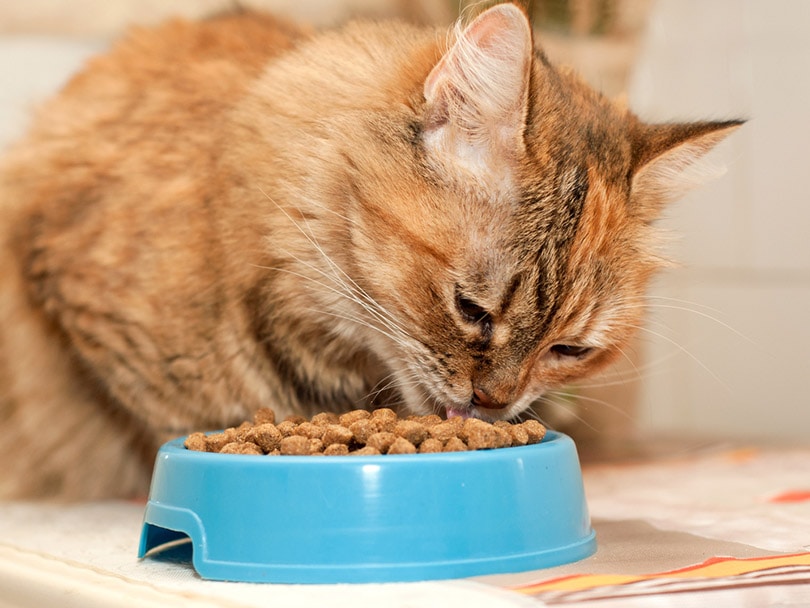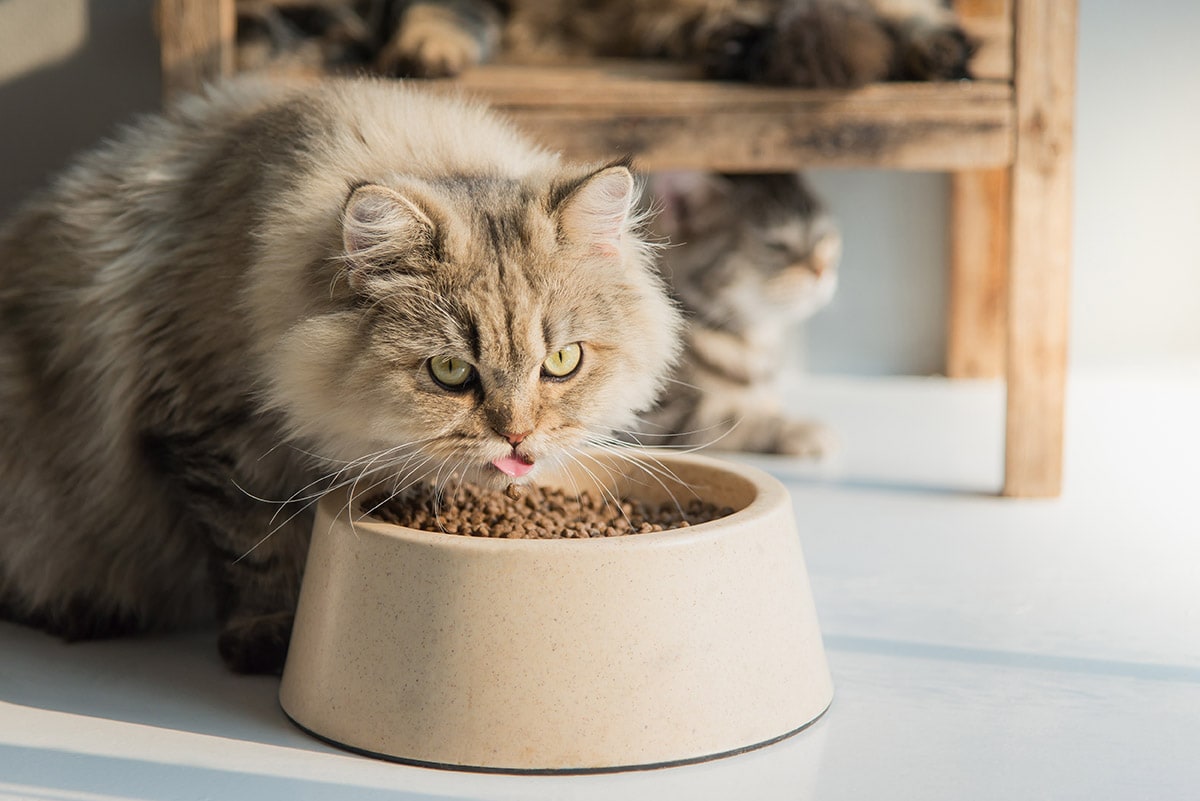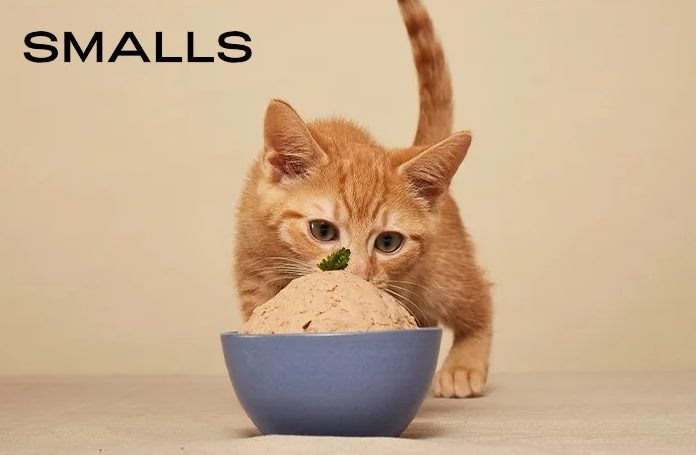
All cats need protein to thrive. They’re obligate carnivores, which means that they must eat meat to meet their nutritional needs.1 In fact, in the wild, they would mostly only be eating meat.
However, some cats need more protein than others. Especially active cats often benefit from higher amounts of protein, as it helps them maintain their muscle mass. Cats with diabetes often need a high-protein diet for management. Other cats simply do better on a high-protein diet.
If your cat falls into one of these categories, take a look at our reviews here. They cover 10 of the best high-protein cat foods on the market.
A Quick Comparison of Our Favorites (2024)
| Image | Product | Details | ||
|---|---|---|---|---|
| Best Overall |

|
Smalls Fresh Cat Food Subscription |
|
Click to Save 40% Use code: PetKeen2023 |
| Budget Buy |

|
Cat Chow Original Dry Cat Food |
|
Check Price |

|
Tiki Cat Grill Sardine Canned Cat Food |
|
Check Price | |

|
Orijen Tundra Dry Cat Food |
|
Check Price | |

|
Instinct Raw Chicken Dry Cat Food |
|
Check Price |
The 10 Best High-Protein Cat Foods
1. Smalls Human-Grade Fresh Cat Food Subscription – Best Overall
| First Five Ingredients: | Chicken thigh, chicken breast, chicken liver, green beans, peas |
| Protein: | 15.5% |
| Fat: | 8.5% |
The best overall high-protein cat food is the Smalls Human-Grade Fresh Bird. The amount of protein in this food is 15.5%, which is a good amount of protein in commercial cat food. Even better is that only 4.7% of metabolizable energy is from carbohydrates in this recipe.
The Smalls cat food is an excellent choice for other reasons, too. The food is human-grade, which means you can even eat it (though you would need to cook it first)! The human-grade quality ensures that your cat gets the safest food. More so, the food is all-natural and free from preservatives, artificial flavors, and colors.
Even if your cat is picky, that shouldn’t be a problem with this food. It comes in three flavors (chicken, turkey, and beef) and two textures (smooth and ground). These options ensure that every cat has a plate for its palette.
Although the recipes are ideal for cats in need of high-protein diets, there is a notable drawback of this food. It is very expensive, making it less suited for those on a budget.
Even though the Smalls Human-Grade cat food is more expensive than its kibble competitors on this list, it is still the best overall pick. After all, it contains an incredibly high amount of protein and is free from ingredients that your cat doesn’t need. This makes the price worth it for those looking for the best!
2. Cat Chow Naturals Original Dry Cat Food — Budget Buy
| First Five Ingredients: | Chicken, corn gluten meal, chicken by-product meal, rice, soybean meal |
| Protein: | 34% |
| Fat: | 13% |
If you’re on a strict budget, Cat Chow Naturals Original Dry Cat Food is a good budget high-protein cat food. It includes chicken as the first ingredient, which is a high-quality protein source.
However, you are sacrificing ingredient quality for a lower price. Much of the protein comes from the included chicken, but also from ingredients like corn gluten meal and soybean meal. These are plant-based ingredients, though they are derivatives that are extremely high in protein. For this reason, much of the protein content likely comes from them, not the chicken.
That said, this food doesn’t include any artificial flavors or preservatives. It is also high in omega-6 fatty acids, which can improve your cat’s overall health.
This food is completely balanced and provides everything that your cat needs in most cases. It just has a few lower-quality ingredients.
3. Tiki Cat Grilled Sardine Cutlets Canned Cat Food
| First Five Ingredients: | Sardines, lobster broth, sunflower seed oil, locust bean gum, guar gum |
| Protein: | 11% |
| Fat: | 3% |
The Tiki Cat Bora Bora Grill Sardine Cutlets in Lobster Consomme Canned Cat Food is another great choice for high-protein cat food. It contains 11% protein, which is quite high for canned cat food.
Much of the included protein seems to come from sardines, which is the first ingredient in this cat food. Sardines are a high-quality animal protein source, making them a great option for most felines. As fish, they are also high in omega fatty acids, which can improve your cat’s skin and coat health.
Omega fatty acids may also help improve arthritis symptoms and protect your cat’s joints. For extra fatty acids, this formula also includes sunflower seed oil.
This formula has added vitamins, amino acids, and taurine. All these ingredients are essential for your cat’s overall health.
Real lobster broth is included, as opposed to simply water. This adds extra nutrition to the broth, including omega fatty acids and protein. It also provides extra hydration, which can be potentially helpful for your feline.
4. Orijen Tundra Premium Grain-Free Dry Cat Food
| First Five Ingredients: | Duck, whole arctic char, steelhead trout, whole pilchard, venison |
| Protein: | 40% |
| Fat: | 20% |
The Orijen Tundra Grain-Free Dry Cat Food is a great option for cats in need of a high-protein dry diet. It includes a wide variety of different animal ingredients, ranging from trout to venison. This helps ensure that your cat is getting all the nutrients that they need.
In fact, this food is made mostly from animal protein sources. About 90% of this food is animal ingredients. Therefore, you can rest assured that the ingredients are top-notch.
This recipe is also made without any added soy, corn, wheat, or tapioca. There are veggies included, but these are far lower in the ingredient list.
This kibble’s coating is freeze-dried raw to ensure that it is flavorful. If your cat is picky, you may find that they accept this food faster than you’d imagine.
That said, this food is significantly more expensive than many others. You’re paying for those quality animal ingredients, after all.
5. Instinct Raw Boost With Real Chicken Dry Cat Food
| First Five Ingredients: | Chicken, chicken meal, turkey meal, menhaden fish meal, peas |
| Protein: | 41% |
| Fat: | 22% |
Instinct Raw With Real Chicken Dry Cat Food is best known for the inclusion of freeze-dried, raw bites mixed with kibble. For many people, this is a cheaper way to add raw food to their cat’s diet, though there isn’t any evidence that raw food provides any significant benefits to cats.
The first ingredient of this food is chicken, followed by chicken meal. The freeze-dried bits are advertised as chicken, so this is likely why chicken is so high on the ingredient list. Turkey and menhaden fish are also both included on the ingredient list.
Probiotics are included in this formula, along with high levels of omega fatty acids. Antioxidants are added for immune support. Grains, potatoes, corn, wheat, soy, and artificial colors are not included.
This formula is quite expensive, however. While you are paying for the freeze-dried ingredients, this food doesn’t contain any extra benefits to improve your cat’s overall health.
6. American Journey Chicken Recipe Dry Cat Food
| First Five Ingredients: | Deboned chicken, chicken meal, tapioca starch, turkey meal, dried egg product |
| Protein: | 40% |
| Fat: | 15% |
American Journey Chicken Recipe Dry Cat Food is average as far as cat food brands go. It isn’t that expensive and has high-quality ingredients throughout.
For instance, deboned chicken is the first ingredient. Chicken meal, turkey meal, and dried egg are also included. All these provide the nutrients that your cat needs to thrive. Together, they help boost the protein content to 40%, which is quite high.
This food includes amino acids like taurine. Antioxidants are also included for immune health, as are omega fatty acids for skin and coat health. This brand is manufactured in the United States.
However, this food does include peas and pea protein, though they are much lower on the list than in other recipes. Therefore, while these ingredients do add plant-based protein, this likely isn’t significant.
7. I and Love and You Essentials Digestive Dry Cat Food
| First Five Ingredients: | Chicken, chicken meal, menhaden fish meal, dried peas, pea starch |
| Protein: | 40% |
| Fat: | 11% |
For the most part, I and Love and You Naked Essentials Digestive Support Dry Cat Food is quite similar to many other cat foods. It has chicken as the first ingredient, and there are chicken meals and menhaden fish meals. All these ingredients provide quite a bit of protein and many of the amino acids that your feline needs to thrive.
As the name suggests, this recipe is specifically designed for digestive health. It includes ingredients like pumpkin, which may benefit cats with regular digestive issues. It is also free from wheat, corn, soy, and other fillers. Probiotics and prebiotics are included.
That said, not all cats appreciate the flavor of this food. In many cases, pickier cats will not eat it at all.
Furthermore, peas are also included in high amounts. They appear as the fourth ingredient in the list. Pea starch and other pea derivatives are included too.
8. Applaws Adult Complete Whitefish Recipe Dry Cat Food
| First Five Ingredients: | Whitefish, whitefish meal, peas, lentils, chicken fat |
| Protein: | 32% |
| Fat: | 16% |
Applaws Adult Complete Whitefish Recipe Dry Cat Food includes whitefish as the first ingredient, followed by whitefish meal. Both of these ingredients are high quality and a great option for most felines.
Peas and lentils are included next. While these aren’t meat ingredients, they are included somewhat low on the list. Therefore, it isn’t likely that substantial amounts of protein come from these ingredients.
That said, this food is exceedingly expensive. You’ll pay quadruple the price for this food compared to many other foods, even the most expensive options. While it does include a few high-quality items, that doesn’t make it worth this price. You can find better for cheaper.
9. Purina Beyond Simply Indoor Salmon Dry Cat Food
| First Five Ingredients: | Salmon, pea starch, chicken meal, pea protein, canola meal |
| Protein: | 33% |
| Fat: | 10% |
Purina is well-known as a budget brand. Its formulas tend to be much cheaper than most others. The Purina Beyond Simply Indoor Salmon Dry Cat Food falls into this category, though it is more expensive than most of the other Purina formulas out there.
This formula has salmon as the first ingredient. Salmon is a high-quality ingredient that adds plenty of protein and fat, including omega fatty acids.
However, pea starch and pea protein are both included on the ingredient list.
The practice of splitting up whole ingredients into parts to make them appear further down on the ingredient list is referred to as “ingredient splitting.” It is a bit misleading. When put together, the pea protein and pea starch would likely appear as the first ingredient.
Peas are quite high in protein. Therefore, much of the protein included in this food likely comes from peas, not salmon.
Furthermore, the value of this brand is also exceedingly low. It just isn’t worth the higher price, especially compared to other Purina lines.
10. Purina ONE Sensitive Skin & Stomach Dry Cat Food
| First Five Ingredients: | Turkey, chicken by-product meal, rice flour, corn gluten meal, soybean meal |
| Protein: | 34% |
| Fat: | 13% |
While Purina is a budget brand, some of its lines are more expensive than others. The Purina ONE Sensitive Skin & Stomach Dry Cat Food is one of its more expensive options out there, though it is still cheap compared to some other brands.
This particular formula is high in protein at 34%. However, it includes low-quality ingredients to achieve this high protein content. While turkey is the first ingredient, chicken by-product meal and corn gluten meal are both included high on the ingredient list.
Therefore, much of the protein included in this recipe isn’t exactly high-quality. For the increased price, this ingredient list isn’t that exciting.
The kibble size of this food is also extremely small. This may be great for some cats, but there are reports of cats having difficulties eating the food due to the small kibble size.
Buyer’s Guide: Choosing the Best High-Protein Cat Food
There are countless reasons that you may be interested in getting high-protein cat food. These will affect your decision over which food is best for your feline.
In this section, we go over all the factors that you may need to consider when choosing high-quality cat food. It is essential that you choose one that fits your cat’s needs and your budget.

Source of Protein
When looking for high-protein cat food, you’re going to run into many formulas stuffed with low-quality, plant-based proteins. While these proteins aren’t necessarily bad, cats often have a hard time absorbing plant-based nutrients.
Many of these don’t contain all the amino acids that your cat needs to thrive, which can lead to deficiencies.
If you want your feline to eat a high-protein diet, you’ll get the most out of complete proteins. These include meats, eggs, poultry, and similar ingredients. They are “complete” in that they include all the necessary amino acids that cats need.
Therefore, you should preferably choose a food that contains mostly meat and other animal-derived ingredients. Soy is technically a complete protein, but it can be saturated in pesticides and should be avoided if possible.
Cat Food Price
Cat food can vary substantially in price. Some foods are extremely expensive, while others are quite cheap. You should choose the best cat food that you can find that also fits your budget.
If you have a fairly strict budget, you’ll often need to cut a few corners to find appropriate food. Generally, we recommend avoiding novel and expensive proteins, like bison and similar ingredients. Instead, you should aim for chicken, beef, and other common proteins. It doesn’t matter that much what sort of animal meat your cat eats, unless they have allergies. You can save quite a bit of money by choosing a more common protein source.
Some brands cost more simply because of their brand name. Purina tends to cost less but has quality formulas, for instance. Blue Buffalo is often quite expensive but doesn’t typically provide many benefits over cheaper foods.
Added Benefits
If your cat is suffering from specific health problems, you may want to prioritize foods that may help with these concerns.
For instance, many obese cats have diabetes, which makes a high-protein diet appropriate. Similarly, many obese cats also have joint problems. Omega fatty acids are extremely helpful in this situation. These are commonly added to many high-protein cat foods.
Cat Life Stage
Just like people, cats have different needs depending on their life stage. Kittens need different nutrition from adults, for instance, because they are growing and developing.
Senior cats will often benefit from a few extra added nutrients, like omega fatty acids. However, completely healthy seniors may not need any extra nutrients at all! It mostly just depends on how your feline has aged.
Therefore, you should choose your cat’s food according to their life stage. Kittens should be fed kitten food for as long as they are growing. Different breeds grow at different rates, so some cats will need kitten food longer than others.
High-quality cat food is an important part of fostering a long and healthy life for your cat but the right cat food and water dish will promote good posture, offer whisker relief, and aid in good digestion. The Hepper NomNom Cat Bowl is our favorite bowl since it offers all of the above and is beautifully crafted to meet modern home stylings. The wide tray design catches any food and water spills and the entire setup is dishwasher safe. Learn more about the Hepper NomNom Cat Bowl here.
At Pet Keen, we’ve admired Hepper for many years and decided to take a controlling ownership interest so that we could benefit from the outstanding designs of this cool cat company!
Conclusion
For many cats, we highly recommend Smalls Human-Grade Fresh Bird for its wholesome list of ingredients and various textures. Each selection is an excellent source of protein and provides the right nutrients cats require.
If you’re on a strict budget, we recommend Cat Chow Naturals Original Dry Cat Food. This food is high in protein and includes chicken as the first ingredient.
Which food you choose should depend on what your cat needs. Some cats will require specific ingredients, like omega fatty acids.
We hope that our reviews have helped you decide on the perfect high-protein cat food for your feline.
Featured Image Credit: Nataliia Dvukhimenna, Shutterstock





















